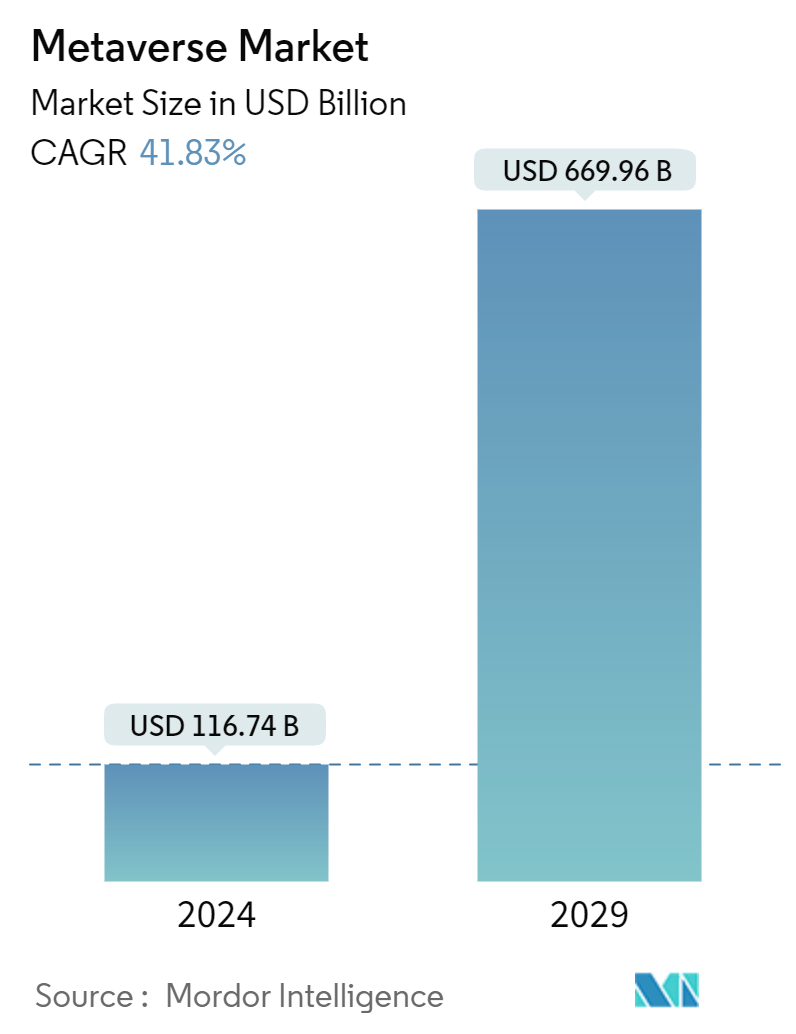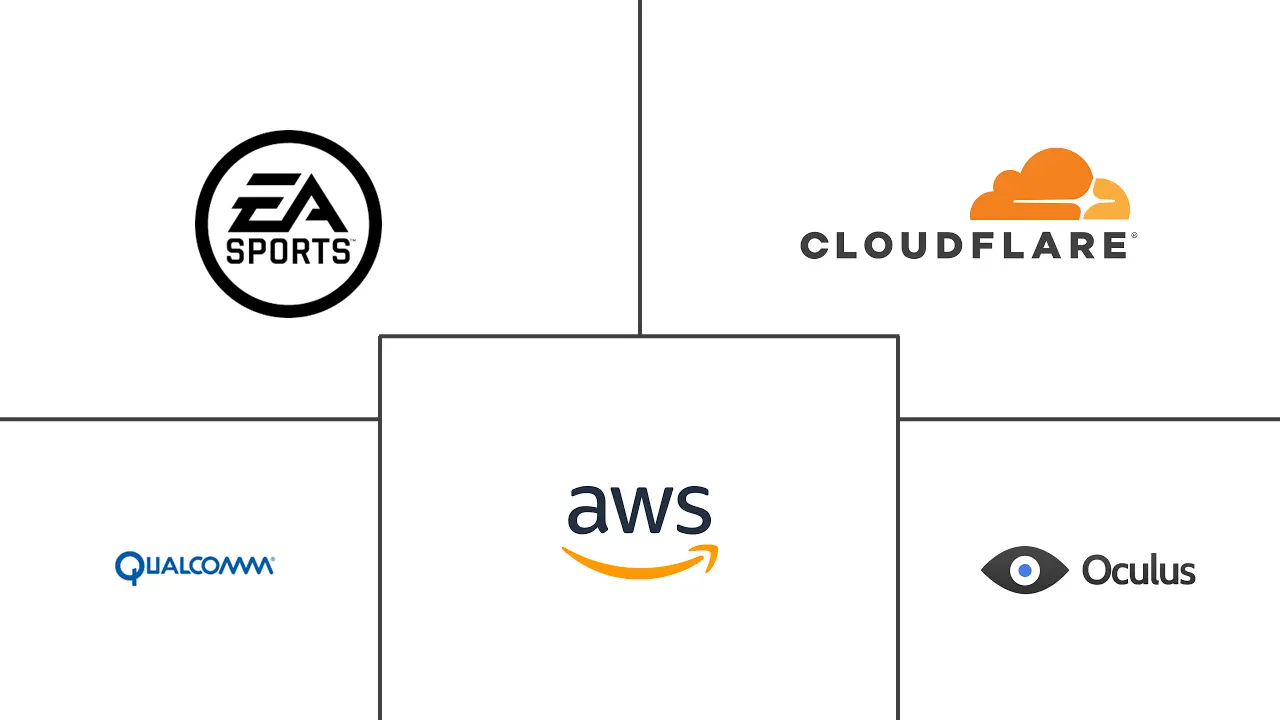Market Size of Metaverse Industry

| Study Period | 2019 - 2029 |
| Market Size (2024) | USD 116.74 Billion |
| Market Size (2029) | USD 669.96 Billion |
| CAGR (2024 - 2029) | 41.83 % |
| Fastest Growing Market | Asia-Pacific |
| Largest Market | North America |
Major Players
*Disclaimer: Major Players sorted in no particular order |
Need a report that reflects how COVID-19 has impacted this market and its growth?
Metaverse Market Analysis
The Metaverse Market size is estimated at USD 116.74 billion in 2024, and is expected to reach USD 669.96 billion by 2029, growing at a CAGR of 41.83% during the forecast period (2024-2029).
The key reasons propelling the growth of the Metaverse Market globally are rising demand in the worldwide media, entertainment, and gaming industries, primarily due to the increased usage of Augmented Reality (AR), Virtual Reality (VR), and Mixed Reality (MR) technologies. The crucial justifications for adopting these technologies are that the gadgets, such as VR headsets, MR headsets, HUD, HMD, smart glasses, and intelligent helmets, can provide a first-person perspective that acts as natural user interfaces, providing 6-degree freedom, etc., to create virtual scenarios that look realistic and improve the overall gaming experience of end users.
- Small, medium-sized, and large-scale businesses and individual customers increasingly need advanced VR gadgets, promoting market expansion. Also, the rising investments in retail and e-commerce and increased use of platforms to display products in a virtual environment support industry expansion.
- Additionally, the market is growing due to the increased use of advanced technologies in various applications, including blockchain, mixed reality, and artificial intelligence (AI). The metaverse industry greatly benefits from the growing usage of new technologies, including mixed reality (MR), extended reality, artificial intelligence (AI), and blockchain. Companies, including Roblox, Facebook, Oculus, Epic Games, Microsoft, Google, USM, NVidia, etc., have already implemented or are implementing Metaverse XR/extended reality systems and other new technologies.
- Moreover, through metaverse portals, cryptocurrency is frequently used to pay for everything, from avatar shoes to NFT (Non-fungible tokens). According to a CNBC survey, one in ten people invests in cryptocurrencies, which are commonly used in trading various commodities, including NFTs. The global accessibility of cryptocurrency exchange allows investors to use this asset to offer products directly to customers on the Metaverse, thus favorably altering the market patterns.
- However, since many users are unaware of the service and security alternatives available, the expansion of the metaverse market may be constrained. Also, on the other hand, cyberattacks against key players like Tencent Holdings, Globant, and others have raised serious security and sensitivity issues.
Metaverse Industry Segmentation
The term "metaverse" refers to a highly immersive 3D virtual world experience obtained using a combination of AR, VR, and MR technologies. By creating a virtual world where users can play immersive games, conduct business, interact socially, buy and sell virtual properties, and enjoy immersive entertainment, the metaverse platform enhances the overall internet experience.
The metaverse market is segmented by type (AR & VR hardware, social media engagement (Ads), virtual live entertainment - epic, games and roblox, gaming services), by end-user industry (gaming, media & entertainment, commercial, retail), and geography (North America, Europe, Asia Pacific, Rest of the World).
The market sizes and forecasts are provided in terms of value (USD) for all the above segments.
| By Type | |
| AR & VR Hardware | |
| Social Media Engagement (Ads) | |
| Virtual Live Entertainment - Epic Games and Roblox | |
| Gaming Services |
| By End-User Industry | |
| Gaming | |
| Media & Entertainment | |
| Commercial | |
| Retail | |
| Others |
| Geography*** | |
| North America | |
| Europe | |
| Asia | |
| Australia and New Zealand | |
| Latin America |
Metaverse Market Size Summary
The Metaverse Market is experiencing significant growth, driven by the increasing demand in media, entertainment, and gaming sectors. This expansion is largely attributed to the enhanced use of Augmented Reality (AR), Virtual Reality (VR), and Mixed Reality (MR) technologies, which offer immersive experiences through devices like VR headsets and smart glasses. These technologies provide natural user interfaces and realistic virtual scenarios, enhancing user engagement and satisfaction. The market is further bolstered by the rising investments in retail and e-commerce, where virtual environments are used to showcase products. The integration of advanced technologies such as blockchain, artificial intelligence, and mixed reality into various applications is also contributing to the market's growth. Major companies like Roblox, Facebook, and Microsoft are actively implementing Metaverse systems, while cryptocurrency transactions within the Metaverse are reshaping market dynamics.
North America is poised to lead the adoption of metaverse solutions, driven by its rapid embrace of sophisticated technologies and significant investments in digital solutions. The region's technological advancements, particularly in AR applications across various sectors like healthcare and aerospace, are propelling market expansion. Companies such as PTC, Magic Leap, and Google are at the forefront, offering innovative AR devices and solutions. The region's burgeoning start-up ecosystem, focusing on metaverse platform commercialization, further enhances market potential. Additionally, strategic partnerships and product developments by established vendors like Qualcomm Technologies and AWS are maintaining competitive momentum. The market's moderate consolidation is evident through strategic acquisitions and collaborations, such as Microsoft's acquisition of Activision Blizzard, aimed at accelerating metaverse industry growth.
Metaverse Market Size - Table of Contents
-
1. MARKET INSIGHTS
-
1.1 Market Overview
-
1.2 Industry Ecosystem Analysis
-
1.3 Industry Attractiveness-Porter's Five Force Analysis
-
1.3.1 Bargaining Power of Suppliers
-
1.3.2 Bargaining Power of Consumers
-
1.3.3 Threat of New Entrants
-
1.3.4 Threat of Substitute Products
-
1.3.5 Intensity of Competitive Rivalry
-
-
1.4 Assessment of the Impact of COVID-19 on the Metaverse Market
-
-
2. MARKET SEGMENTATION
-
2.1 By Type
-
2.1.1 AR & VR Hardware
-
2.1.2 Social Media Engagement (Ads)
-
2.1.3 Virtual Live Entertainment - Epic Games and Roblox
-
2.1.4 Gaming Services
-
-
2.2 By End-User Industry
-
2.2.1 Gaming
-
2.2.2 Media & Entertainment
-
2.2.3 Commercial
-
2.2.4 Retail
-
2.2.5 Others
-
-
2.3 Geography***
-
2.3.1 North America
-
2.3.2 Europe
-
2.3.3 Asia
-
2.3.4 Australia and New Zealand
-
2.3.5 Latin America
-
-
Metaverse Market Size FAQs
How big is the Metaverse Market?
The Metaverse Market size is expected to reach USD 116.74 billion in 2024 and grow at a CAGR of 41.83% to reach USD 669.96 billion by 2029.
What is the current Metaverse Market size?
In 2024, the Metaverse Market size is expected to reach USD 116.74 billion.

